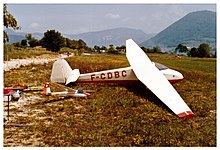| This article needs additional citations for verification. Please help improve this article by adding citations to reliable sources. Unsourced material may be challenged and removed. Find sources: "Scheibe Spatz" – news · newspapers · books · scholar · JSTOR (May 2007) (Learn how and when to remove this message) |
| Spatz | |
|---|---|
 L-Spatz 55 D-1738 L-Spatz 55 D-1738 | |
| General information | |
| Type | Sailplane |
| National origin | Germany |
| Manufacturer | Scheibe |
| Number built | 471 (L-Spatz) |
| History | |
| First flight | 1952 |
The Scheibe Spatz (German: "Sparrow") is a German glider with a mixed metal and wood construction that was built in 1952 until 1962. Later versions were known as the L-Spatz, the letter L standing for Leistung, which is German for "performance".
Scheibe Flugzeugbau built the Spatz A in 1952. Two years later in 1954 the first L-Spatz 55 was airborne. Three hundred L-Spatz 55s were built in Germany, 155 in France under the name Avialsa A.60 Fauconnet, and 16 in Italy as the Meteor MS-30 L Passero; production was discontinued in 1962.
It is a single-seater cantilever shoulder-winged sailplane with a cruising (max L/D) speed of 45 mph. It has an empty weight of 157 kg and a maximum take-off weight of 269 kg. The single spar wing and tail were constructed using fabric-covered wood, whereas the fuselage consisted of steel tubing covered with fabric.
The L-Spatz 55 has good climbing performance due to light construction. The glide angle is 29:1. The longest known cross-country flight was more than 600 km from Burg Feuerstein, Germany to France.
Many gliding clubs operated the L-Spatz 55, well known for its easy handling, including easy recovery from a spin.
Variants
- Spatz A
- Certified in 1952 with a 13.20 metre wingspan, 6.19 m length.
- Spatz B
- Strengthened and improved variant with a 13.20 metre wingspan, 6.19 m length, certified in 1952.
- Spatz 55
- Certified in 1952 with a 13.20 metre wingspan, 6.25 m length.
- L-Spatz
- Certified in 1954 with a 15.00 metre wingspan, 6.05 m length.
- L-Spatz 55
- Certified in 1954 with a 15.00 metre wingspan, 6.25 m length.
- L-Spatz III
- Certified in 1966 with a 15.00 metre wingspan, 6.25 m length.

- Avialsa 60 Fauconnet
- Licence production in France.
- Meteor MS-30 L-Passero
- Licence production in Italy.
- Electravia Electro Light 2
- Electric aircraft version powered by an electric drive system, with a nose-mounted propeller.
Aircraft on display
- Museum für Luftfahrt und Technik
- National Soaring Museum
- Museum of Military Technique GRYF in Dąbrówka near Wejherowo (Poland)
Specifications (L-Spatz 55)
Data from The World's Sailplanes:Die Segelflugzeuge der Welt:Les Planeurs du Monde
General characteristics
- Crew: 1
- Length: 6.25 m (20 ft 6 in)
- Wingspan: 15 m (49 ft 3 in)
- Wing area: 11.7 m (126 sq ft)
- Aspect ratio: 19
- Airfoil: Mü-Profil 14%
- Empty weight: 153 kg (337 lb)
- Max takeoff weight: 265 kg (584 lb)
Performance
- Never exceed speed: 180 km/h (110 mph, 97 kn)
- Rough air speed max: 110 km/h (68 mph; 59 kn)
- Aerotow speed: 110 km/h (68 mph; 59 kn)
- Winch launch max speed: 90 km/h (56 mph; 49 kn)
- Terminal velocity: 200 km/h (124.3 mph; 108.0 kn)
- g limits: +4 -2
- Maximum glide ratio: 29 at 80 km/h (50 mph; 43 kn)
- Rate of sink: 0.58 m/s (114 ft/min) at 67 km/h (42 mph; 36 kn)
- Wing loading: 22.6 kg/m (4.6 lb/sq ft)
See also
Aircraft of comparable role, configuration, and era
Notes
- Tacke, Willi; Marino Boric; et al: World Directory of Light Aviation 2015-16, page 166. Flying Pages Europe SARL, 2015. ISSN 1368-485X
- National Soaring Museum (2011). "Sailplanes in Our Collection". Archived from the original on 16 May 2011. Retrieved 28 July 2011.
- Shenstone, B.S.; K.G. Wilkinson (1958). The World's Sailplanes:Die Segelflugzeuge der Welt:Les Planeurs du Monde (in English, French, and German) (1st ed.). Zurich: Organisation Scientifique et Technique Internationale du Vol a Voile (OSTIV) and Schweizer Aero-Revue. pp. 68–72.
References
- Shenstone, B.S.; K.G. Wilkinson (1958). The World's Sailplanes:Die Segelflugzeuge der Welt:Les Planeurs du Monde (in English, French, and German) (1st ed.). Zurich: Organisation Scientifique et Technique Internationale du Vol a Voile (OSTIV) and Schweizer Aero-Revue. pp. 68–72.
External links
| Aircraft designed and built by Scheibe | |
|---|---|
| Unpowered | |
| Powered | |